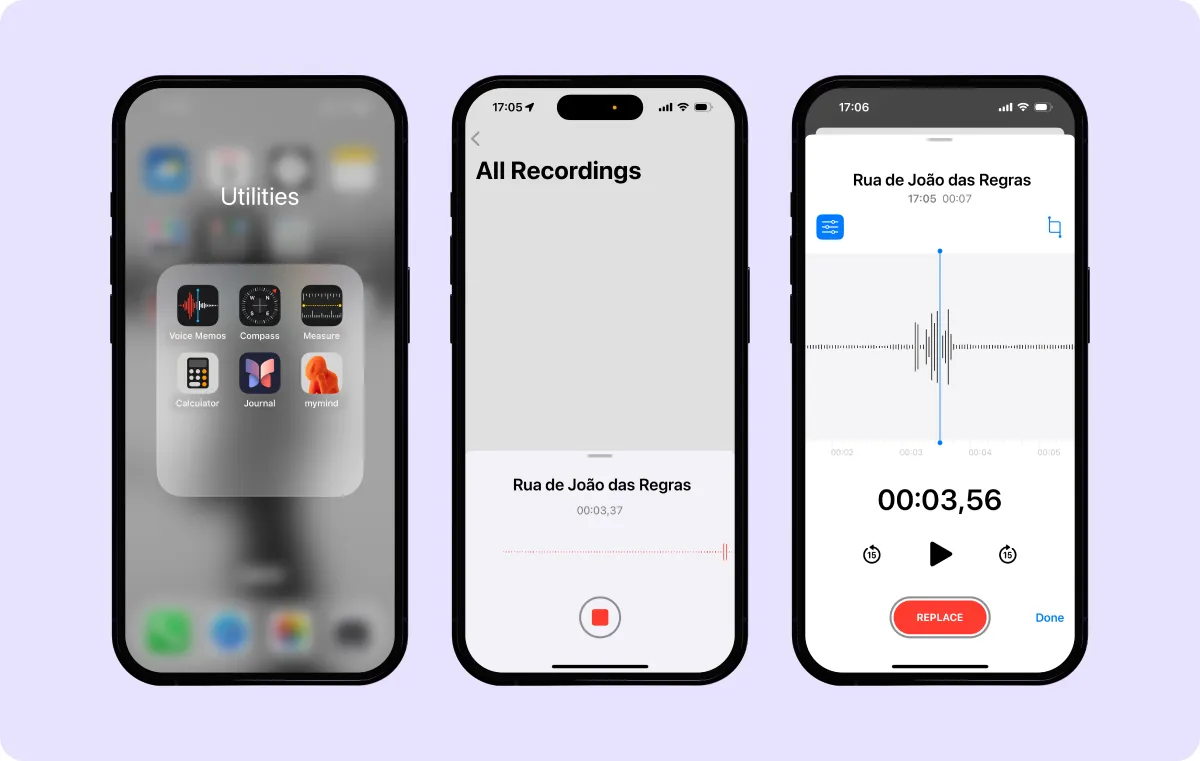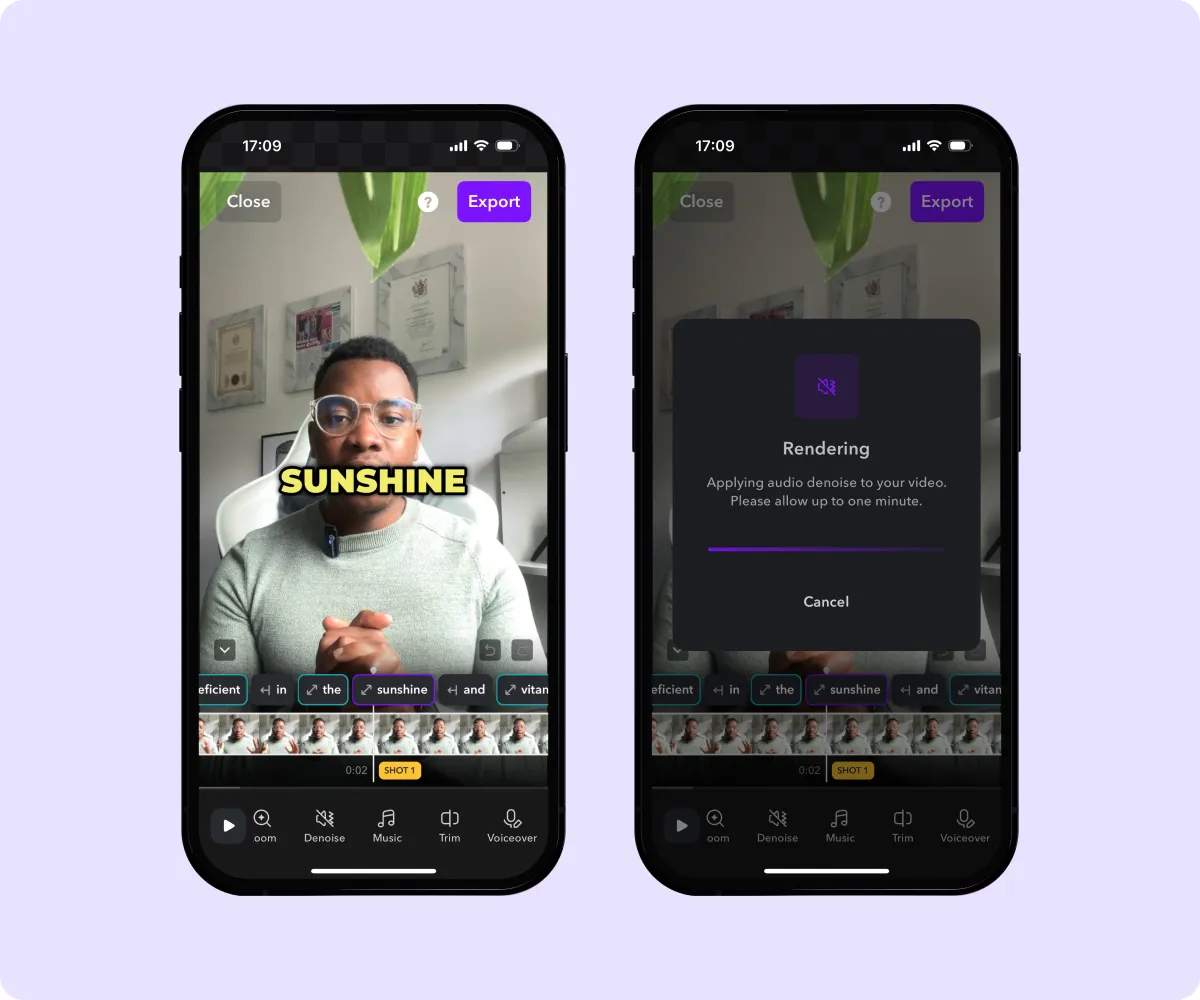High-quality audio takes any video up a notch, and thankfully, the iPhone in your pocket is a powerful audio recording tool. Whether you're capturing voice notes for your next video idea, adding a voiceover, or creating a podcast, an iPhone can record crisp audio takes with a few adjustments and tricks.
Read on to learn how to record audio on an iPhone using best practices for improving sound quality.
Can You Record Audio With an iPhone?
Yes, every iPhone comes with built-in microphones and the Voice Memos app, making it easy to record high-quality sound at the tap of a button. The recording app has a user-friendly interface and unlimited recording time, so it’s a great option for content creators on the go.
How To Record Audio With Voice Memos on iPhone: 6 Steps
Capturing high-quality audio on your iPhone is easy with Voice Memos. Here’s a step-by-step guide to help you make the most of this tool.
1. Open the App
Find the Voice Memos app on your iPhone — it's preinstalled and should be on your home screen. If you can't find it, use the search feature or ask Siri to open the app.
2. Press the Red “Record” Button
Tap the large red circle at the bottom of the screen to start recording, and you’ll see the waveform reflecting your audio as it captures sound. Speak clearly and at a consistent volume for the best results.
3. Expand the Recording Screen
While recording, drag the small handle in the middle of the screen upward to make the voice recorder view larger. This gives you a larger display of your audio levels, making it easier to monitor volume and catch any background noise.
4. Use "Pause" or "Stop" To Control Your Recording

If you need to take a break between the audio clip, tap "Pause" to temporarily halt the recording. This way, you won't have unnecessary gaps, making editing easier later. When you're ready to continue, tap “Resume.” To end your recording, tap the "Stop" button, and your iPhone will automatically save it.
5. Name Your Recording
Click "New Recording" to give your audio a specific file name. Renaming the audio clip as soon as you record it can help you identify it quickly and save time later, especially if you're recording multiple takes for different projects.
6. Edit the Clip
Go to the "All Recordings" menu and find your audio file. Tap the three-dot icon and choose "Share" from the drop-down menu. Select “Save to Files” to download the clip.
Import your audio into Captions, and let AI edit your sound. Adjust the volume, add sound effects, and reduce background noise automatically.
Best Practices for Recording High-Quality Audio on Your iPhone
Here are some tips to make the most of your iPhone’s recording capabilities and capture clear audio for your next project.
Keep the Microphone Clean and Unblocked
Your iPhone’s microphone can pick up dust, debris, and lint, especially if it’s been in your pocket or bag. Before recording, gently wipe the microphone with a soft, lint-free cloth to ensure no particles block it. Avoid covering the microphone with your hands or other objects during recording. Instead, hold the phone by the edges or set it down on a flat surface so sound reaches it directly.
Place Your Phone in an Uncluttered Space
Put your iPhone on a steady, open surface so it doesn't pick up unwanted vibrations or muffled sounds. Even subtle movements can cause a handheld iPhone to capture rustling sounds, so setting the phone down provides a stable base for clear audio without interruptions. Avoid placing it near hard surfaces that can create echoes. Instead, opt for a slightly cushioned or cloth-covered area to soften reflections.
Speak Loudly and Clearly
Creating a clean take means you spend less time editing during post-production. For the best recording results:
- Keep your distance — Position yourself about six to twelve inches from the microphone. This distance keeps your voice sharp while avoiding any distortion that comes from being too close.
- Master your mic — Speak clearly and project your voice confidently into the mic. You can also practice your recording voice’s tone and pacing, especially if you’re creating audio for a podcast or tutorial.
- Watch your volume — Avoid whispering or speaking too softly, as this can introduce hissing sounds and require extra editing. Keep your voice at a steady volume and avoid sudden changes in tone to maintain a smooth, even sound throughout the recording.
Silence Your Phone
Recording on your phone means you might get calls or notifications when capturing audio. Set your iPhone on airplane mode or mute notifications to prevent any background dings or buzzes that could ruin a great take. Airplane mode also conserves battery and focuses your phone's processing power on the Voice Memos app, giving you the best possible recording quality.
Reduce Background Noise

Your iPhone's mic is sensitive, meaning it can capture external sounds that easily disrupt a recording. To avoid interruptions:
- Find the perfect space — Record sounds on your iPhone in a quiet, enclosed location.
- Minimize noise — Close any windows, turn off fans and other noisy appliances, and record in a room with carpet or soft furniture to help absorb sound.
- Soundproof the room — For extra sound dampening, surround your recording area with pillows or blankets. Consider adding acoustic panels to your home studio for a more permanent solution.
These tips will remove echoes and make the audio sound warmer. Even if you don’t capture the perfect audio, Captions’ AI Denoise feature automatically removes background noise. Whether you’re recording outdoor vlogs or cooking videos, Captions makes your audio sound more professional when recording on your iPhone.
Improve Your Audio Quality With Captions
You can achieve high-quality audio on your iPhone using the Voice Memos app and following best practices. However, even with careful recording, some background noise can make its way into your files.
That's where Captions comes in. With AI Denoise, Captions automatically reduces background sounds and cleans your audio for a studio-level final result. It's easy to use, and you don't need complex audio equipment or extensive editing skills.
Start using Captions for your editing and create professional-grade audio.
FAQs
How Do I Record Internal Audio on My iPhone?
Apple’s privacy restrictions limit internal audio recording for app sounds or video game audio. If you’re screen recording on an iPhone, specific apps and media allow audio capture along with the video (though it doesn’t work with all apps). To enable this, open the "Control Center," tap and hold the "Screen Recording" icon, and turn on "Microphone Audio" to capture both internal and external sounds where allowed.
What’s the Best Way to Record Audio on an iPhone?
The best way to record audio natively on an iPhone is through voice recording apps like Voice Memos and GarageBand. These apps are preinstalled on all iPhones and are easy to use.
How Long Can You Record on an iPhone?
The length of an audio recording on an iPhone depends on the available storage space. While Voice Memos and other recording apps don't have time limits, larger files will consume more storage, especially if you record at a higher quality. Before starting a lengthy audio take, check your storage and free up space if necessary so the recording doesn't stop halfway through.
Can You Screen Record Phone Calls on an iPhone?
No, iPhones don’t allow users to screen-record phone calls with sound due to privacy restrictions. Recording calls typically requires third-party apps or screen recorders, many of which might not work directly on iPhones due to Apple’s policies.









